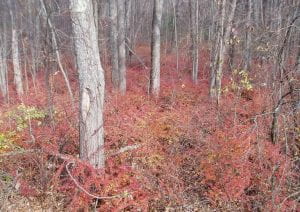
As you spend time outside in nature, you become more familiar with the flora (plants) and fauna (animals). Some plants are native to our area, while others have been introduced. Some of these introduced species are considered invasive meaning that they are nonnative to our area and can cause environmental or economic harm or harm to humans.
Unfortunately there are lots of invasive species in our area. This week we are asking you to familiarize your self with a few of them and see if you can spot them.
Vocabulary
- native – A species that occurs naturally in a specified geographic area.
- nonnative – A species that does not occur naturally in a specified geographic area.
- introduced – A species brought to a new geographic area intentionally or unintentionally by humans.
- established – A species having a self-sustaining and reproducing population in a specified geographic area without the need for human intervention. Applies to both native and nonnative species.
- invasive – A species that (a) is nonnative to a specified geographic area, (b) was introduced by humans (intentionally or unintentionally), and (c) does or can cause environmental or economic harm or harm to humans.
- nuisance – An individual or group of individuals of a species that causes management issues or property damage, presents a threat to public safety, or is an annoyance. This can apply to both native and nonnative species.
- perennial – A plant that lives for several or many years.
This week’s the challenge is look for invasive species.
- Take a walk around your neighborhood, a local park, or somewhere else where you can find nature.
- See if you can spot any invasive species.
- Take some pictures and submit them here.
Below are some of the more common invaisve species found in our area.
PLANTS
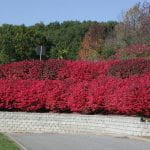 Burning Bush (Euonymus alatus)
Burning Bush (Euonymus alatus)
Burning bush is a perennial woody shrub commonly used in landscaping as it is fast growing, easy to maintain, deer resistant, and has beautiful bright red fall foliage. It is easy to spot at this time of year as it leaves are a bright red. Look for red colored hedges or stand alone plants.
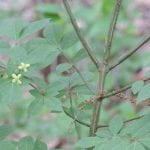 Unfortunately this beautiful plant has become invasive. It produces hundred of berries each year which are dispersed by birds in to natural areas where in readily establishes. It produces thick stands which threaten native diversity and productivity of natural habitats.
Unfortunately this beautiful plant has become invasive. It produces hundred of berries each year which are dispersed by birds in to natural areas where in readily establishes. It produces thick stands which threaten native diversity and productivity of natural habitats.
Learn more about Burning Bush.
 Common Reed (Phragmites australis)
Common Reed (Phragmites australis)
This perennial grass can grow over 15 feet tall and is commonly found in marsh and wetland areas and along roadsides.
Common reed grows in dense stands that crowd out native vegetation and do not support the diversity needed for a thriving ecosystem.
Japanese Barberry (Berberis thunbergii)
 Japanese barberry is a woody plant that can grow 3 to 6 feet tall and 3 to 6 feet wide. Its foliage varies from green to dark reddish purple. It commonly used in landscaping around homes and businesses, because of its color and its resistance to deer.
Japanese barberry is a woody plant that can grow 3 to 6 feet tall and 3 to 6 feet wide. Its foliage varies from green to dark reddish purple. It commonly used in landscaping around homes and businesses, because of its color and its resistance to deer.
Unfortunately, this plant produces hundreds of little red berries which are spread by birds and small mammals. This has led to barberry escaping into woody areas where it grows in dense thickets disrupting native ecosystems.
Learn more about Japanese Barberry.
Japanese Knotweed (Reynoutria japonica / Polygonum cuspidatum)
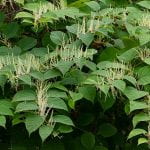 Japanese knotweed is a non-woody perennial meaning that it comes back year after year. It grows in dense thickets that crowd and shade out native vegetation. It has underground stems called rhizomes that can reach 30-75 feet in length and are the main way this plant spreads.
Japanese knotweed is a non-woody perennial meaning that it comes back year after year. It grows in dense thickets that crowd and shade out native vegetation. It has underground stems called rhizomes that can reach 30-75 feet in length and are the main way this plant spreads.
 This plant grows around waterways and is commonly seen along road ways. In the fall the leaves turn yellow and fall to the ground. The hollow stems die and turn brown.
This plant grows around waterways and is commonly seen along road ways. In the fall the leaves turn yellow and fall to the ground. The hollow stems die and turn brown.
Learn more about Japanese Knotweed.
Norway Maple (Acer platanoides)
 Norway maple trees were commonly planted in yards and along streets. Unfortunately it invades forested areas an out competes the native sugar maple. It also is one of the first trees to leaf out in the spring and blocks sunlight from reaching all of the early spring flowers which reduces wildflower diversity.
Norway maple trees were commonly planted in yards and along streets. Unfortunately it invades forested areas an out competes the native sugar maple. It also is one of the first trees to leaf out in the spring and blocks sunlight from reaching all of the early spring flowers which reduces wildflower diversity.
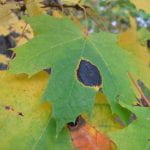 Norway maple trees have large leaves with five lobes. At this time of year, many of them are still holding on their leaves which eventually turn bright yellow. This tree is very susceptible to a fungal disease called tar spot, so you may see large black spots on their leaves.
Norway maple trees have large leaves with five lobes. At this time of year, many of them are still holding on their leaves which eventually turn bright yellow. This tree is very susceptible to a fungal disease called tar spot, so you may see large black spots on their leaves.
Learn more about Norway Maple Trees.
INSECTS
Emerald Ash Borer (Agrilus planipennis)

The emerald ash borer is wood boring beetle that invades and kills ash tree. Most ash trees in our area have been infected and many have already died. While you won’t find the beetle itself at this time of year you can see the damage it has caused. The larvae of the emerald ash borer feed right underneath the bark leaving large circuitous galleries behind. These galleries preventing the transportation of sugars throughout the tree which eventually kills the tree. If you peel back the bark of an infected tree you can see the galleries.
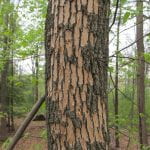
Woodpeckers love to eat emerald ash borer larvae. They peck at the trees to get at the larvae and this causes the bark to slough off. This is the most commonly noticed symptom of the emerald ash borer, although once you see this, you tree is as good as dead.
Learn more about Emerald Ash Borer.
Spotted Lanternfly (Lycorma delicatula)
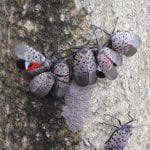
The spotted lanternfly is one of the newest invasive species here in Orange County. This beautiful plant hopper is not yet wide-spread throughout the county, but has been found in several places including Port Jervis and Newburgh. It currently wide-spread in Pennsylvania and New Jersey, so when visiting these states be on the look out for hitchhikers.
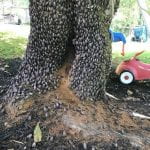 These beautiful bugs are a nuisance. They congregate in massive groups. They eat large quantities of sap and as a result expel large quantities of a sticky substance referred to as honey dew. This sticky substance readily grows a black fungus called sooty mold and also attracts wasps, bees, and ants.
These beautiful bugs are a nuisance. They congregate in massive groups. They eat large quantities of sap and as a result expel large quantities of a sticky substance referred to as honey dew. This sticky substance readily grows a black fungus called sooty mold and also attracts wasps, bees, and ants.

At this time of year you may find an adult, but you are more likely to come across an egg mass. They will lay their eggs on any flat surface including but not limited to trees, tarps, outdoor furniture, and cars. If you think you found a spotted lanternfly or spotted lanternfly eggs, please report it to the New York State Dept. of Agriculture and Markets using the Spotted Lanternfly Public Report.
Learn more about Spotted Lanternfly.
What are you waiting for? Get outside and start looking for some invasive species. They are more common then you might think.
Don’t forget to take some pictures of the invaisve species you find and submit them to the 2021 Get Outside Nature Challenge.
